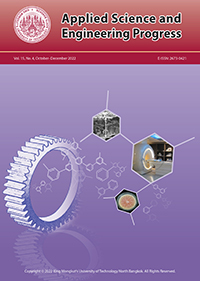Multi-Objective Optimization of UV Spot Curing Technique of Slider-Suspension Attachment Process Using Response Surface Methodology Approach
Main Article Content
Abstract
The ultraviolet (UV) curing of slider-suspension attachment is going to change from a manual to an automated process. As a result, the bonding parameters of adhesive between slider and suspension needs to be optimized. This paper aims to study two output responses of the UV curable epoxy adhesive i.e., shear strength force and pitch static attitude (PSA) of the joint between slider and suspension in a head gimbal assembly (HGA). Four process parameters were investigated using response surface methodology (RSM) based on face-centered central composite design (FCCD). The RSM was applied to establish a mathematical model to correlate the significance of process parameters and the responses. Then, the based multi-objective was applied to determine a quadratic model and obtained the output maximization at 224 g of shear strength force and PSA value close to the target at 1.8 degrees. The input process parameters were optimized at 0.7 s of UV bottom cure time, 120 °C of UV dual side temperature, 5.0 s of UV dual side cure time, and 230 μm of adhesive dot size. The validation experiment showed a prediction response error of less than 7% of the actual value.
Article Details
References
J. Lin, Z. Lu, H. Yang, and P. Wang, “A design of experiments assessment of moisture content in uncured adhesive on static strength of adhesivebonded galvanized SAE1006 steel,” International Journal of Adhesion and Adhesives, vol. 31, pp. 478–485, 2011.
J. LeBono, L. Barton, and M. Birkett, “Low temperature tensile lap-shear testing of adhesively bonded polyethylene pipe,” International Journal of Adhesion and Adhesives, vol. 74, pp. 57–63, 2017.
S.-W. Lee, J.-W. Park, C.-H. Park, D.-H. Lim, H.-J. Kim, J.-Y. Song, and J.-H. Lee, “UV-curing and thermal stability of dual curable urethane epoxy adhesives for temporary bonding in 3D multichip package process,” International Journal of Adhesion and Adhesives, vol. 44, pp. 138–143, 2013.
R. Aradhana, S. Mohanty, and S. K. Nayak, “A review on epoxy-based electrically conductive adhesives,” International Journal of Adhesion and Adhesives, vol. 99, 2020, Art. no. 102596.
Ž. Unuk, A. Ivanič, V. Ž. Leskovar, M. Premrov, and S. Lubej, “Evaluation of a structural epoxy adhesive for timber-glass bonds under shear loading and different environmental conditions,” International Journal of Adhesion and Adhesives, vol. 95, 2019, Art. no. 102425.
J. T. Gruener, A. Vashisth, M. J. Pospisil, A. C. Camacho, J.-H. Oh, D. Sophiea, S. E. Mastroianni, T. J. Auvil, and M. J. Green, “Local heating and curing of carbon nanocomposite adhesives using radio frequencies,” Journal of Manufacturing Processes, vol. 58, pp. 436–442, 2020.
D. Quan, B. Deegan, L. Byrne, G. Scarselli, A. Ivanković, and N. Murphy, “Rapid surface activation of carbon fibre reinforced PEEK and PPS composites by high-power UV-irradiation for the adhesive joining of dissimilar materials,” Composites Part A: Applied Science and Manufacturing, vol. 137, 2020, Art. no. 105976.
K. Schmidt and A. Zimmermann, “Evaluation of process and anisotropy of thermosetting adhesives with ultraviolet-assisted 3D dispensing,” Additive Manufacturing, vol. 34, 2020, Art. no. 101262.
A. N. Rider, C. H. Wang, and J. Cao, “Internal resistance heating for homogeneous curing of adhesively bonded repairs,” International Journal of Adhesion and Adhesives, vol. 31, pp. 168–176, 2011.
T. Vallée and M. Adam, “Inductively cured glued-in rods in timber using curie particles,” International Journal of Adhesion and Adhesives, vol. 70, pp. 37–45, 2016.
A. H. Lutey and F. Moroni, “Pulsed laser texturing for improved adhesive-bonded polyethylene (PE) joints,” International Journal of Adhesion and Adhesives, vol. 102, 2020, Art. no. 102676.
L. Sutherland, C. Amado, and C. G. Soares, “Statistical analyses of the effects of bonding parameters and fabrication robustness on the strength of adhesive T-joints,” Composites Part B: Engineering, vol. 175, 2019, Art. no. 107063.
P. R. Oliveira, M. May, T. H. Panzera, F. Scarpa, and S. Hiermaier, “Reinforced biobased adhesive for eco-friendly sandwich panels,” International Journal of Adhesion and Adhesives, vol. 98, 2020, Art. no. 102550.
F. Moroni, L. Romoli, and M. Khan, “Design of laser-textured surfaces to enhance the strength of adhesively bonded joints,” International Journal of Adhesion and Adhesives, vol. 85, pp. 208–218, 2018.
J. Lasprilla-Botero, M. Álvarez-Láinez, D. A. Acosta, and J. M. Martı́n-Martı́nez, “Waterbased adhesive formulations for rubber to metal bonding developed by statistical design of experiments,” International Journal of Adhesion and Adhesives, vol. 73, pp. 58–65, 2017.
J. Deeying, K. Asawarungsaengkul, and P. Chutima, “Multi-objective optimization on laser solder jet bonding process in head gimbal assembly using the response surface methodology,” Optics & Laser Technology, vol. 98, pp. 158–168, 2018.
B. F. Ryan, B. L. Joiner, and J. D. Cryer, MINITAB Handbook: Update for Release. Massachusetts: Cengage Learning, 2012.
D. C. Montgomery, Design and Analysis of Experiments. New Jersey: John Wiley & Sons, 2012.


